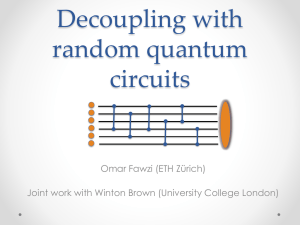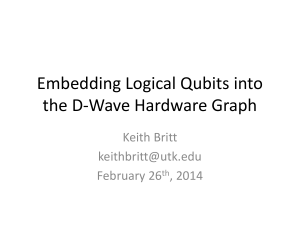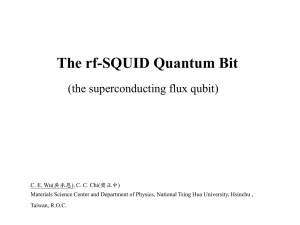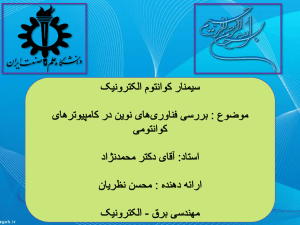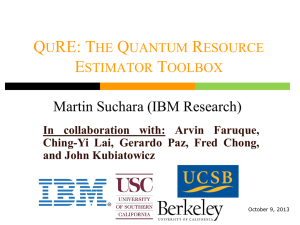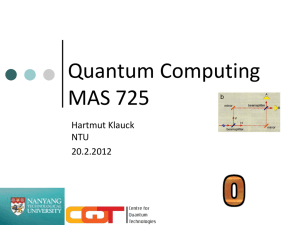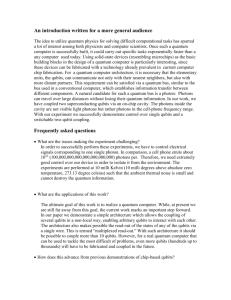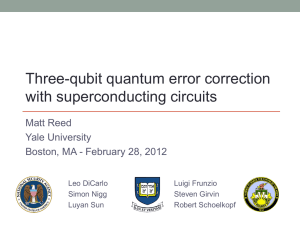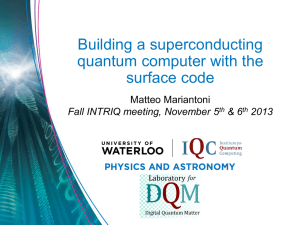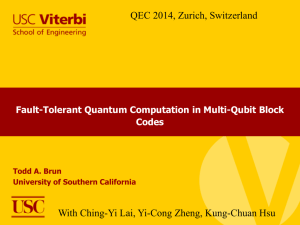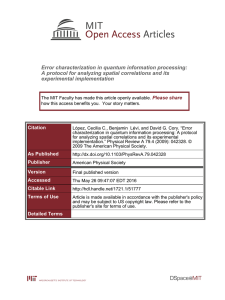ppt - QEC14
advertisement
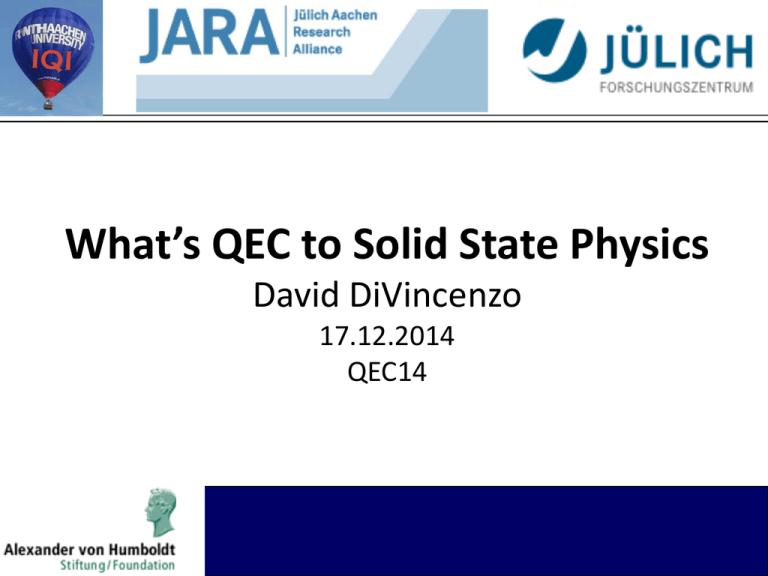
What’s QEC to Solid State Physics David DiVincenzo 17.12.2014 QEC14 Outline • Surface codes everywhere (and even color codes) • Various rough approximations of scalability • Attempting to get error & leakage rates under control – example from quantum dot qubits • The highly complex classical world of surface codes – example from UCSB/Google • Outside the gate model – one-shot syndrome measurement • Inside the gate model – Fibonnaci anyons A development of 1996-7: X X In Quantum Communication, Computing, and Measurement, O. Hirota et al., Eds. (Plenum, New York, 1997). Stabilizer generators XXXX, ZZZZ; Stars and plaquettes of interesting 2D lattice Hamiltonian model X X Z Z Z Z A development of 1996-7: X X In Quantum Communication, Computing, and Measurement, O. Hirota et al., Eds. (Plenum, New York, 1997). Stabilizer generators XXXX, ZZZZ; Stars and plaquettes of interesting 2D lattice Hamiltonian model X X Z Z Z Z Colorized thanks to Jay Gambetta and John Smolin Surface code Q Q Q Q Q Q Q Q |0Q Q |0Q Q |0Q Q Q Q Q Q Q Q Q Q |0Q Q |0Q Q |0Q Q Initialize Z syndrome qubits to One level of abstraction – CNOTs on square lattice with data qubits (blue) and ancilla qubits (red and green) Slightly less abstract – geometric layout of qubits & couplers to implement desired square lattice Blue: data Red/green: ancilla Numbering: qubits with distinct transition frequencies “Realistic” chip layout of qubits and resonators • Qubits (green) coupled via high-Q superconducting resonators (gray) • “skew-square” layout of qubits and resonators is one way to achieve abstract square • Every qubit has a number of controller and sensor lines to be connected to the outside world (gold pads) DP. DiVincenzo, “Fault tolerant architectures for superconducting qubits,” Phys. Scr. T 137 (2009) 014020. Another “Realistic” surface code layout in 3D circuit-QED architecture Syndrome measurements without the execution of a quantum circuit DiVincenzo & Solgun, New J. Phys. 2013 Another “Realistic” surface code layout for doublequantum-dot qubit Mehl, Bluhm, DiVincenzo “Fault-Tolerant Quantum Computation for SingletTriplet Qubits with Leakage Errors,” in preparation arXiv:1411.7403 Not obvious that this is a scalable implementation Progress error correction in ion traps, But another not-really-scalable setup Fig. S4 Steane 7-qubit error correction code as first step to “color code carpet” Uni. Innsbruck Two-electron spin qubits Electrostatic gates GaAs heterostructure 90 nm + + + + + + + + + + + + + 2D electron gas Individual confined electrons Thanks to Hendrik Bluhm, RWTH Qubit manipulation E S(0, 2) Qubit states S 1 2 J() 0 << 0: Free precession Bext+Bnuc,z T0 1 2 DBz ~< 0: Coherent exchange T0 J S potential energy There are many kinds of noise (e.g., charge noise) Representative gate • 10 to 32 pulse segments • Reminiscent of Rabi, but more fine structure. 1 - F ≈ 0.2 % typical => Good gates exist, but can these complicated pulses actually be tuned? First experimental steps – Pascal Cerfontaine and Hendrik Bluhm Experimental trajectory reconstructed via self-consistent state tomography (Takahashi et al, PRA 2013). Entangling operation of STQs singly occupied: exchange 18.-21.08.2014 | DiVincenzo Mehl & DiVincenzo, PRB 90, 045404 (2014) 19 Essential: Leakage Reduction Units Similar (but not worse than) entangling gates Mehl, Bluhm, DiVincenzo, in preparation Vision: Scalable architecture Needed: quantum information theorists 21 Case study: Back to UCSB/Google Classical control: 23 control wires for the 9 qubits! Waveforms of classical signals going to the dilution refrigerator 10 kW power consumption Final observation on UCSB/Google: -- Their instinct (also DiCarlo, TU Delft) is to report error rates of full Cycles; focus is not on individual gate errors An architecture to do surface code operations without using the circuit model 4 “transmon” qubits antenna coupled to cubical electromagnetic cavity DiVincenzo & Solgun, New J. Phys. 2013 Phase shift of signal reflected from cavity vs. frequency 0000 qubit state 0001 0011 1111 θ is the same for all even states (mod 2π) θ is the same for all odd states (mod 2π) 0111 θeven≠θodd “Fibonacci” Levin-Wen Model Levin & Wen, PRB 2005 v p H Q v Bp v Vertex Operator Qv = 0,1 p Plaquette Operator Bp = 0,1 Trivalent Lattice Ground State Qv = 1 on each vertex Bp = 1 on each plaquette “Fibonacci” Levin-Wen Model Levin & Wen, PRB 2005 v p H Q v Bp v Vertex Operator Qv = 0,1 p Plaquette Operator Bp = 0,1 Trivalent Lattice Ground State Qv = 1 on each vertex Bp = 1 on each plaquette Excited States are Fibonacci Anyons H Q v Bp Vertex Operator: Qv j Qv i v k ijk v j i v k p “Fibonacci” Levin-Wen Model 100 010 001 0 All other ijk 1 H Q v Bp Plaquette Operator: Bp v p Bp 1 on each plaquette superposition of loop states b b a B s p i n j p m f a c k d l B s , i j k l m n p , ijklmn abcdef i j k l m n i’ f 0 Bp 1 1 2 s , i j k l m n B p , ijklmn l’ m’ d e e Bp Bp k’ p n’ c j’ abcdef Fs i n F s j i F s k j F s l k F s m l F s n m Very Complicated 12-qubit Interaction! ani bij cjk dkl elm fmn Quantum Circuit for Measuring Bp 2 1 8 7 6 3 9 p 12 10 11 5 4 1 2 3 4 5 6 7 8 9 10 11 12 b b b b b b b b b c e a d c e a d c e a d c e a d 0 c e a b a b a b X c e a c e a d c e a d c e a d c e a d 1 Bp N. Bonesteel, D.P. DiVincenzo, PRB 2012 Gate Count 2 1 8 7 6 3 9 p 12 10 11 4 5 1 2 3 4 5 6 7 8 9 10 11 12 b c e a d b c e a d b b b c e c a e c a e d d a 0 b c a e b a a b b b b c c e c e a e a a d d d b c e a d X 1 Bp 8 2 10 43 24 5-qubit Toffoli Gates 4-qubit Toffoli Gates 3-qubit Toffoli Gates CNOT Gates Single Qubit Gates 371 392 CNOT Gates Single Qubit Rotations N. Bonesteel, D.P. DiVincenzo, PRB 2012 Outline • Surface codes everywhere (and even color codes) • Various rough approximations of scalability • Attempting to get error & leakage rates under control – example from quantum dot qubits • The highly complex classical world of surface codes – example from UCSB/Google • Outside the gate model – one-shot syndrome measurement • Inside the gate model – Fibonnaci anyons What’s QEC for Solid State Physics? “Surface code” is on the lips of many a solid-state device physicist these days. I will document this phenomenon with some examples, from the commonplace (CNOT to ancillas, then measure) to the more recondite (direct parity measurement, intrinsic leakage of DFS qubits). I will give some examples from current work in quantum-dot qubits. Mighty efforts are underway to improve laboratory fidelities, which are however neither quantitatively nor methodologically complete. Leakage reduction units are starting to come over the horizon, but QEC could probably help more with this. There are correspondingly mighty plans on the drawing board to collect and process all the data that the surface code implies. I will show what small parts of these plans have come to fruition; QEC should also do some work to determine what is really the best thing to do with this avalanche of data, when it comes. I will also touch on some examples where solid-state physics definitely gives back to QEC, with Fibonacci quantum codes being one example. Project group A Quantum information architectures Error correction A1-3 Interaction between qubits • SAW spin transfer (A4) • Semiconductor Josephson elements (A5-7) “Fibonacci” Levin-Wen Model Levin & Wen, PRB 2005 v Trivalent Lattice H Q v Bp v Vertex Operator Qv = 0,1 p “Fibonacci” Levin-Wen Model Levin & Wen, PRB 2005 v p H Q v Bp v Vertex Operator Qv = 0,1 p Plaquette Operator Bp = 0,1 Trivalent Lattice arXiv:1205.1910 • No gate action among the three qubits • Three qubits coupled dispersively to each of two nearly degenerate resonant modes • Measurement by reflectometry: tone in at + port, detect phase of tone out at – port • Designed as quantum eraser: measures only ZZZ (parity) A two-resonator device for measuring the parity of three qubits: χ=g2/Δ s1, s2, s3 are the states of the three qubits (0,1) χi is dispersive shift parameter Dispersive coupling is the same for each qubit and the same on both resonators (a and b) Wave impedance “looking into” port A (transmission line theory) (Z0=50Ω) Reflection coefficient of full structure NB Alternative solution of Mabuchi and coworkers Project group B Semiconductor multi-qubit circuits Transistors optimized for cryogenic control Control system ZEA-2, FZJ Engineering (B3) Optical interface to qubits: B7,B8 Qubits Physics Scalable multi-qubit circuits: B1 Material optimization: B2 Decoherence: B4-B6 High fidelity gates • Well-established spin qubits, key operations demonstrated • Detailed knowledge of dephasing characteristics Key requirement: Gates with error rate <~ 10-4 • What fidelities can be reached in the face of realistic hardware constraints? • How can systematic errors be eliminated? Dephasing due to nuclear spins New insights – Pronounced effects on Hahn echo from: • Nuclear quadrupole splitting T • g-factor anisotropy DBz 0 J 90° echo amplitude 75° 60° 45° 30° 15° 0° 0 10 20 evolution time (µs) 30 S Triple Quantum Dot Qubit exchange-only qubit PRB 87, 195309 (2013) 18.-21.08.2014 | DiVincenzo Title 48 Triple Quantum Dot Qubit exchange-only qubit PRB 87, 195309 (2013) 18.-21.08.2014 | DiVincenzo Title 49
